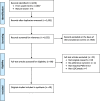Systematic review of HIV treatment adherence research among people who inject drugs in the United States and Canada: evidence to inform pre-exposure prophylaxis (PrEP) adherence interventions
- PMID: 30621657
- PMCID: PMC6323713
- DOI: 10.1186/s12889-018-6314-8
Systematic review of HIV treatment adherence research among people who inject drugs in the United States and Canada: evidence to inform pre-exposure prophylaxis (PrEP) adherence interventions
Abstract
Background: People who inject drugs (PWID) are at increased risk for HIV acquisition and could benefit from antiretroviral pre-exposure prophylaxis (PrEP). However, PrEP has been underutilized in this population, and PrEP adherence intervention needs are understudied.
Methods: To inform PrEP intervention development, we reviewed evidence on antiretroviral therapy (ART) adherence among HIV-infected PWID. Guided by a behavioral model of healthcare utilization and using the PICOS framework, we conducted a systematic review in four electronic databases to identify original research studies of ART adherence in HIV-infected PWID in the United States and Canada between Jan 1, 2006-Dec 31, 2016. We synthesized and interpreted findings related to developing recommendations for PrEP adherence interventions for PWID.
Results: After excluding 618 duplicates and screening 1049 unique records, we retained 20 studies of PWID (mean n = 465) with adherence-related outcomes (via pharmacy records: n = 9; self-report: n = 8; biological markers: n = 5; electronic monitoring: n = 2). Predisposing factors (patient-level barriers to adherence) included younger age, female sex, and structural vulnerability (e.g., incarceration, homelessness). Enabling resources (i.e., facilitators) that could be leveraged or promoted by interventions included self-efficacy, substance use treatment, and high-quality patient-provider relationships. Competing needs that require specific intervention strategies or adaptations included markers of poor physical health, mental health comorbidities (e.g., depression), and engagement in transactional sex.
Conclusions: HIV treatment adherence research carries important lessons for efforts to optimize PrEP adherence among PWID. Despite limitations, this systematic review suggests that strategies are needed to engage highly vulnerable and marginalized sub-groups of this underserved population (e.g., younger PWID, women who inject drugs) in PrEP adherence-related research and programming.
Keywords: Adherence; Antiretroviral therapy; Drug use; People who inject drugs; Pre-exposure prophylaxis; Prevention.
Conflict of interest statement
Ethics approval and consent to participate
Not applicable – no human subjects
Consent for publication
Not applicable
Competing interests
The authors declare that they have no competing interests.
Publisher’s Note
Springer Nature remains neutral with regard to jurisdictional claims in published maps and institutional affiliations.
Figures
Similar articles
-
Study protocol for an efficacy trial of the "PrEP for Health" intervention to increase HIV PrEP use among people who inject drugs.BMC Public Health. 2023 Mar 17;23(1):513. doi: 10.1186/s12889-023-15429-w. BMC Public Health. 2023. PMID: 36932369 Free PMC article.
-
Perspectives on HIV pre-exposure prophylaxis (PrEP) utilization and related intervention needs among people who inject drugs.Harm Reduct J. 2018 Nov 12;15(1):55. doi: 10.1186/s12954-018-0263-5. Harm Reduct J. 2018. PMID: 30419926 Free PMC article.
-
Qualitative inquiry into perceptions of HIV pre-exposure prophylaxis among people who inject drugs living with hepatitis C in Seattle, WA, USA.Harm Reduct J. 2022 Nov 1;19(1):121. doi: 10.1186/s12954-022-00706-5. Harm Reduct J. 2022. PMID: 36320005 Free PMC article.
-
The Pre-exposure Prophylaxis (PrEP) Care Cascade in People Who Inject Drugs: A Systematic Review.AIDS Behav. 2021 May;25(5):1490-1506. doi: 10.1007/s10461-020-02988-x. AIDS Behav. 2021. PMID: 32749627 Free PMC article.
-
Preexposure Prophylaxis for the Prevention of HIV Infection: Evidence Report and Systematic Review for the US Preventive Services Task Force.JAMA. 2019 Jun 11;321(22):2214-2230. doi: 10.1001/jama.2019.2591. JAMA. 2019. PMID: 31184746
Cited by
-
HIV Pre-exposure Prophylaxis and Buprenorphine at a Drug Detoxification Center During the Opioid Epidemic: Opportunities and Challenges.AIDS Behav. 2021 Aug;25(8):2591-2598. doi: 10.1007/s10461-021-03220-0. Epub 2021 Mar 22. AIDS Behav. 2021. PMID: 33751315 Free PMC article.
-
Study protocol for an efficacy trial of the "PrEP for Health" intervention to increase HIV PrEP use among people who inject drugs.BMC Public Health. 2023 Mar 17;23(1):513. doi: 10.1186/s12889-023-15429-w. BMC Public Health. 2023. PMID: 36932369 Free PMC article.
-
Acceptability of long-acting antiretroviral therapy among people living with HIV who use drugs in Vancouver, Canada: A qualitative study.PLoS One. 2025 Feb 28;20(2):e0319010. doi: 10.1371/journal.pone.0319010. eCollection 2025. PLoS One. 2025. PMID: 40019916 Free PMC article.
-
Examining adherence barriers among women with HIV to tailor outreach for long-acting injectable antiretroviral therapy.BMC Womens Health. 2020 Jul 25;20(1):152. doi: 10.1186/s12905-020-01011-8. BMC Womens Health. 2020. PMID: 32711509 Free PMC article.
-
"Ashamed of being seen in an HIV clinic": a qualitative analysis of barriers to engaging in HIV care from the perspectives of patients and healthcare workers in the Daraja clinical trial.BMC Public Health. 2025 Jan 7;25(1):69. doi: 10.1186/s12889-024-21231-z. BMC Public Health. 2025. PMID: 39773172 Free PMC article.
References
-
- WHO | People who inject drugs. WHO. 2016. http://www.who.int/hiv/topics/idu/about/en/. Accessed 14 Feb 2018.
-
- Vickerman P, Hickman M, May M, Kretzschmar M, Wiessing L. Can hepatitis C virus prevalence be used as a measure of injection-related human immunodeficiency virus risk in populations of injecting drug users? An ecological analysis. Addiction. 2010;105:311–318. doi: 10.1111/j.1360-0443.2009.02759.x. - DOI - PubMed
Publication types
MeSH terms
Substances
Grants and funding
LinkOut - more resources
Full Text Sources
Medical
Research Materials
Miscellaneous


